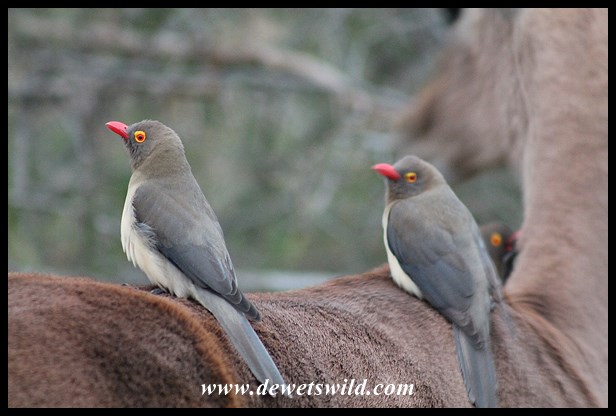Buphagus erythrorhynchus
Red-billed Oxpeckers subsists almost entirely on a diet of ticks and their larvae, maggots and other ecto-parasites, picked from the hides and orifices of large mammalian herbivores. They will however also peck at open wounds to feed on the blood. They are therefore closely associated with savannas and woodlands inhabited by good numbers of these large host animals, associating especially with the hairier game species like giraffes and antelope, as well as cattle and donkeys. Adults are about 20cm long and weigh around 50g.
At night, Red-billed Oxpeckers sleep in small flocks in trees, being especially fond of lalapalms. These birds nest in holes in trees lined with the fur of wild and domesticated mammals, particularly in the wet summer months. Usually there are three eggs in a clutch, incubated by both parents.
Red-billed Oxpeckers occur from Eritrea southwards to South Africa, where they can be found in the provinces of Kwazulu-Natal, Mpumalanga, Limpopo, Gauteng and Northwest, while an isolated population seems to have become established in the Eastern Cape as well. The eradication of wild game and the dipping of cattle has a detrimental impact on the food supply of the Red-billed Oxpecker, causing their populations outside protected areas to decline and, while the IUCN still views it as being of Least Concern, they are considered Near Threatened in South Africa and regularly reintroduced to reserves in areas from which they were previously exterminated.

Red-billed Oxpecker

Kudu bull with an oxpecker irritation

Red-billed Oxpecker clinging to a kudu

Red-billed Oxpecker climbing into a zebra’s ear

Red-billed oxpeckers

Buffalo and oxpecker in discussion

Red-billed oxpeckers on a giraffe’s back

Immature red-billed oxpecker on juvenile impala

Red-billed oxpeckers

Red-billed Oxpecker

Red-billed Oxpecker

Red-billed Oxpeckers pecking at an open wound on a buffalo

Red-billed Oxpecker

Red-billed Oxpecker

Red-billed Oxpecker

Red-billed Oxpecker

Red-billed Oxpecker

Red-billed Oxpecker

Red-billed Oxpecker

Red-billed Oxpecker

Sleepy buffalo and red-billed oxpecker

Red-billed Oxpeckers

Red-billed Oxpecker

Red-billed Oxpeckers

Red-billed Oxpecker

Red-billed Oxpecker

Red-billed Oxpeckers

Red-billed Oxpeckers

Red-billed Oxpecker

Red-billed Oxpecker

Red-billed Oxpeckers

Red-billed Oxpeckers

Red-billed Oxpecker

Red-billed Oxpecker

Red-billed Oxpecker

Red-billed Oxpecker on buffalo

Red-billed Oxpecker lining nest with fur

Red-billed Oxpecker

Red-billed Oxpecker

Red-billed Oxpecker

Red-billed Oxpecker juvenile

Red-billed Oxpecker juvenile

Red-billed Oxpecker (photo by Joubert)

Red-billed Oxpecker (photo by Joubert)

Red-billed Oxpecker

Young Red-billed Oxpeckers

Red-billed Oxpecker

Red-billed Oxpeckers and flies hanging around the back of a White Rhino

Red-billed Oxpecker (photo by Joubert)

Red-billed Oxpeckers

Impala ewe with a heavy load of red-billed oxpeckers

Impala ewe that’s had enough of free-loading Red-billed Oxpeckers (photo by Joubert)

Red-billed Oxpeckers on a nyala bull























































Ahhh – so that’s the little bird I saw hitchhiking on the giraffe!! I guess the big animals tolerate them because they provide a service by getting rid of the insects in their hair … but not quite so benevolent when they decide to start pecking in a wound. Ouch!
LikeLiked by 1 person
A case of “can’t live with them, can’t live without them” for most of Africa’s large herbivores!
😀
LikeLiked by 1 person
Love these!! They certainly seem to have lots of friends! 🙂 🙂
LikeLiked by 1 person
And very tolerant friends at that!
LikeLiked by 1 person
Bit like Pigeons for the hide. As stated, we see them in movies and take little notice. I like how the animals let them do their stuff. Nice to know their name. Thanks for sharing this.
LikeLike
Welcome here, Ted, and thanks for weighing in – It really is amazing just how much the animals tolerate them digging into their ears, noses and whatever else!
LikeLike
Fantastic photos again, were they taken in Kruger?
LikeLiked by 1 person
Thanks, Kim! About half of the photos are from Kruger – the rest are from the Zululand reserves and one from Marakele.
LikeLiked by 1 person
Pragtig.
LikeLiked by 1 person
Dankie, Spokie!
LikeLike
Amazing photo’s
LikeLiked by 1 person
Thanks a lot, Antoinette!
LikeLike
It´s a very beautiful bird. You see them in most nature movies from Africa but never actually get any notice of them. I have never looked at them so close, before now in your pictures, and it´s a beautiful bird.
LikeLiked by 1 person
Thanks John! Indeed, they’re almost always part of the picture, and the background sounds, but never the stars!
LikeLiked by 1 person
That’s an interesting survival strategy and it may prove to be not too successful.
LikeLiked by 1 person
Thanks for the interesting point of view, Montucky! My take is that if they do go extinct it would only be because of human interference in their food supply, which is a very real possibility.
LikeLiked by 1 person
The name made me giggle! A symbiosis relationship, called commensalism ( I looked that up!) lol… Neat bird! 😉
LikeLiked by 1 person
Indeed, Teresa: a relationship that benefits both species. Unless the oxpeckers starts pecking at open wounds and keep them from healing…
LikeLiked by 1 person
just imagining that, Yuck, gives me the hibby jibbies lol 🙂
LikeLiked by 1 person
😀
LikeLike